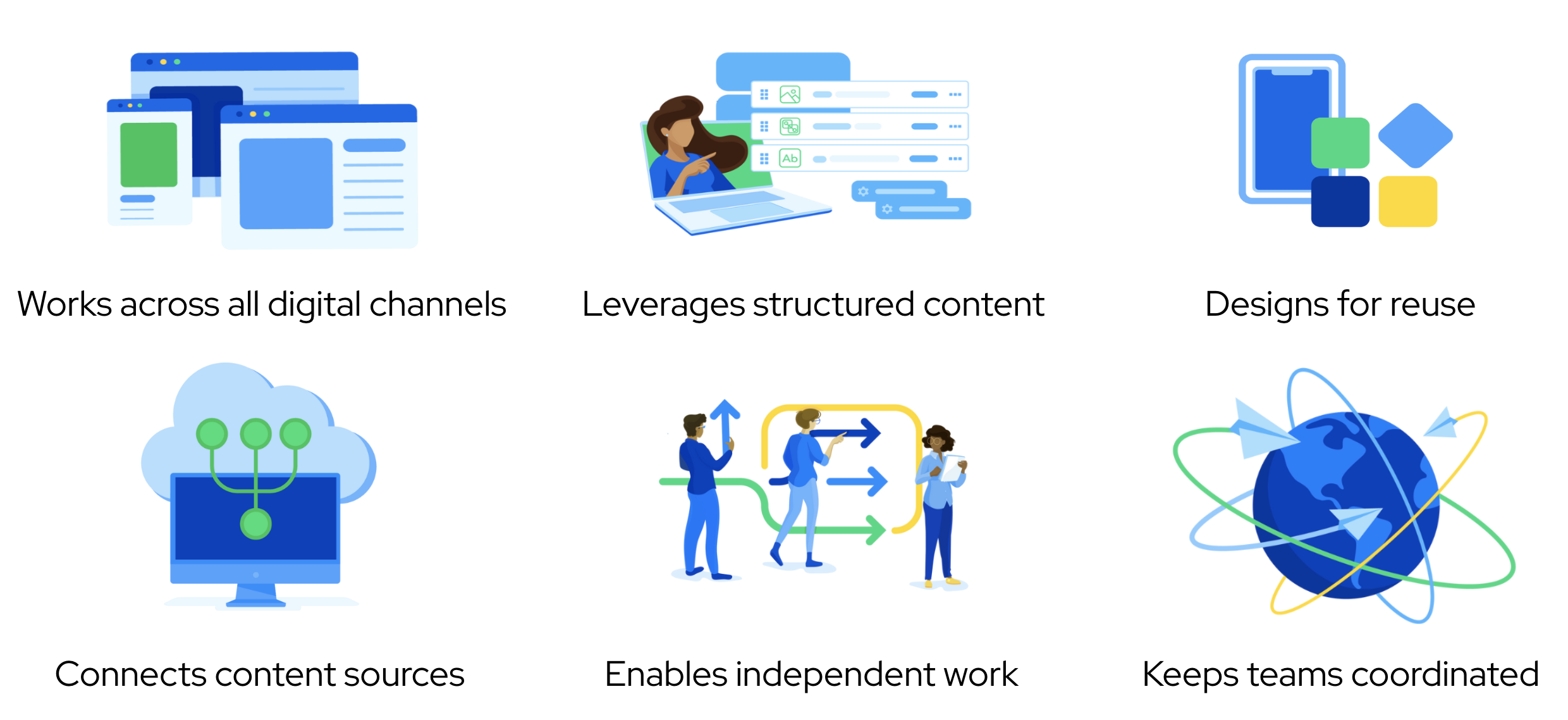Embrace composable content: A new approach for marketers in the digital age

Composable content is a new approach to managing digital content in today’s world, where digital channels are ever present in our professional and personal lives. This concept addresses the challenges that arise from the overwhelming noise and blurred boundaries between digital and in-person experiences.
As marketers and businesses, it is crucial to think differently about content, going beyond just websites, mobile apps, social media, and email marketing. Composable content involves considering various media formats and channels, including gaming communities and in-game promotions, to effectively engage with audiences across all digital platforms.
In a recent discussion on composable content for marketers, Nicole France, Director of Content at Contentful, was joined by Liz Miller, Vice President and Principal Analyst at Constellation Research, and Justin Gonzales, Global Head of Customer Empowerment at Square. You can watch an on-demand recording of the conversation here.
Composability is a new way of thinking about (and working with) content
To succeed in today’s digital landscape, marketers must manage content at scale, considering factors such as the variety of digital experiences, platforms, channels, teams, organizations, geographies, languages, and audiences. Being able to quickly experiment and iterate is crucial for capturing the attention of target audiences and building long-term relationships.
This requires better ways of framing and operating, as well as different tools to achieve consistency, operational efficiency, and ease of work. Marketing has never lacked good ideas, however, the challenge has often been the ability to execute them. By adopting a composable content approach, marketers can more effectively implement their ideas and engage with audiences across various digital platforms.
Six attributes of composable content
Composable content offers six core attributes that enable marketers to work more effectively across digital channels and manage content at scale:
Works across digital channels: Composable content is not tied to a specific channel or platform, allowing marketers to manage content across various channels from one place.
Leverages structured content: By using structured content and content modeling, marketers can easily reuse content elements in different combinations, tailoring experiences for specific channels or audiences.
Enables content reuse: Structuring content effectively allows for content reuse, providing building blocks to compose tailored experiences for customers or other audiences.
Connects content from various sources: Composable content unites content from different organizational structures, teams, and systems to create cohesive experiences.
Allows for independent work: Individuals and teams can work independently within their areas of expertise without stepping on colleagues’ toes or being dependent on them to complete tasks.
Enables coordinated collaboration: While working independently, teams can still collaborate as needed, working toward a common goal and ensuring that content is consistent, accurate, and aligned with organizational objectives.
By adopting a composable content approach, marketers can create more effective and engaging experiences across digital platforms while efficiently managing content at scale.

The importance of treating content as an ecosystem
Early in the discussion, Justin shared his perspective as a customer experience advocate and leader at Square and Block. He emphasized the importance of treating content as an ecosystem and ensuring consistency across all touchpoints throughout the customer journey, from awareness to retention and even churn. He noted that it’s essential to ensure a smooth experience at each stage, as it ultimately affects the brand’s image.
His approach focuses on creating and maintaining content in a way that reduces the amount of oversight and effort while empowering customers. This involves considering how different content sources, such as marketing, sales, account management, and product, interact with each other and contribute to a unified customer experience.
Justin highlighted the importance of understanding that a brand is the story customers tell to others. This means that all aspects of the customer experience, including content and service, must align to create a consistent and positive narrative. If there’s a disconnect between different organizations within a company, the brand’s image can suffer. By adopting a composable content approach, businesses can ensure that their content aligns with their brand and overall customer experience.
Stop random acts of customer experience
Liz chimed in to discuss the idea of stopping random acts of customer experience. She mentioned the challenge of coordinating sales, service, and marketing to work together while avoiding territorial behavior. Liz highlighted that a brand’s story is not only about the products but also about why customers engage with it and what sets it apart from others. This story is told by a chorus of storytellers, including service representatives handling difficult customer interactions.
She pointed out that many businesses get caught up in a content checklist and forget about the importance of involving everyone in the content creation process. By including all stakeholders in the storytelling process, businesses can better capture the essence of their brand and create a more cohesive and compelling narrative across all customer touchpoints.
During the discussion, the panelists touched upon the importance of maintaining a visual and editorial style that doesn’t appear like a patchwork. Justin emphasized the importance of composable content in achieving this, as it allows teams to share and repurpose content effectively. Collaboration between different functions and a common goal is essential for consistency in visual and editorial styles.
Nicole added that content modeling and coordination are crucial for avoiding a patchwork appearance. Separating content from where it gets displayed enables the creation of design systems that apply across digital channels. She highlighted the importance of having a design system for the entire visual identity of the organization.
Liz reminded everyone that sometimes patchworks can be okay, as long as they don’t compromise the brand’s overall consistency. She discussed the organizational challenges faced by marketing teams, which tend to be organized by channel, leading to rigidity.
In summary, to avoid a patchwork appearance in content, it is vital to focus on collaboration, composable content, content modeling, and consistent design systems across the organization.

Striking a balance between consistency and freedom
During the discussion, Liz highlighted that being overly rigid about brand standards can hinder flexibility, creativity, and collaboration. Instead, it is important for organizations to strike a balance between consistency and freedom for teams to create within guidelines.
Nicole mentioned the importance of communication and content operations (content ops) in establishing this balance. Systems such as design systems, composable content platforms, and storyworlds can help maintain consistency while allowing creative freedom.
The panelists agreed that a mindset change is needed, one that empowers people across the business to create within guidelines while still allowing for flexibility, creativity, and the ability to engage different audiences. This mindset shift should focus on inspiring creativity, providing the right tools, and ensuring consistency where it matters most.
By establishing strong guardrails and providing the necessary tools, organizations can foster collaboration, creativity, and consistency across various teams and channels, ultimately delivering a cohesive and engaging customer experience.
Maintaining a consistent brand image while encouraging creativity and audience-driven content
Creating guardrails for content allows teams to have fun and enjoy themselves while still hitting the marks and maintaining a consistent brand image. It is important to acknowledge that within each channel, the brand can show up differently.
For example, technical documentation might be straightforward and concise, while content on TikTok may showcase a more playful side of the brand. Having guardrails in place ensures that everyone is aiming for the same target, even with these different representations.
Having a little structure is crucial, especially in global organizations and marketing teams. It is essential to provide permission for creativity within those guardrails. Content operation practices, guidelines, and permission to innovate are vital for ensuring consistency and creativity across global teams.
Costa Coffee serves as an excellent example of a company successfully implementing composable content. When expanding into other countries, they realized that it was not just a question of translating their content, but also understanding the preferences and values of their new audiences. By having guardrails and allowing for creativity, Costa Coffee was able to tailor their content to different markets while maintaining a consistent brand image.
The panelists discussed the importance of being audience-driven when creating content. It is essential to focus on the audience’s needs and preferences and reach them effectively. This could mean providing the right information, entertaining them, or introducing them to new ideas and concepts.
Justin shared his perspective on engagement, highlighting that his team’s priority is customer empowerment by helping customers achieve their goals. To achieve this, they focus on predicting potential issues customers may face and proactively delivering content that addresses these issues. They also work on creating experiences that allow customers to find answers quickly and easily.
Measuring the success of content involves considering the different goals and KPIs for each customer objective. The panelists emphasized the need for creative thinking, understanding the customer journey, and measuring pain points and friction to continuously improve the content experience for customers. By being audience-driven and focusing on customer empowerment, businesses can create more engaging and effective content across various channels.

Embracing composable content and personalization
Justin discussed the importance of helping customers adapt and adopt solutions, whether through creating a Square Academy for seamless onboarding or using chatbots and artificial intelligence to support customers in achieving their goals. The more creative and critical thinking applied to these processes, the more efficient they can become.
Liz reminisced about the pre-digital era when sales representatives would manually create composable content by cutting and pasting different parts of ads together. She highlighted that the reason marketing didn’t create multiple incarnations of content in the past was due to the time it took to produce them.
In the present day, marketing leads must think about where the best answers are coming from and how to use them in their content creation. By leveraging the advancements in technology and innovative thinking, marketers can now create more efficient and engaging content while saving time and resources. This focus on customer needs and creative problem-solving will ultimately lead to better content experiences and improved customer engagement.
Liz pointed out that customer service teams are a valuable source of content, as they answer a wide variety of questions from customers. By being less rigid and focusing on how content is already being delivered, organizations can unlock new opportunities for content creation.
One aspect of this is coordinating internally and making content visible, findable, and usable by different teams across the organization. This approach addresses the sales rep’s need to repurpose content to better meet audience needs.
Another aspect is personalization. While one-to-one personalization may not be entirely achievable, the goal is to create content that feels personal, contextual, and relevant to the recipient. This can be accomplished by understanding and anticipating their needs.
Liz emphasized that personalization should go beyond simple “digital mail merge” techniques. By stepping back and considering all the elements of content, marketers can harness the power of composable content to serve the needs and preferences of their audience more effectively. This approach enables organizations to create more personalized and engaging content experiences.
Focus on what feels personal to the audience
Liz explained the importance of focusing on what feels personal to the audience, rather than fitting content into a predefined categorization of personalization. By understanding the context and knowing what resonates with customers, businesses can create content that feels personal and relevant.
Marketers often spend time on micro-segmentation, but personalization should be about meeting customer expectations without being creepy or stalker-like. Flipping the paradigm and focusing on the customer’s definition of personalization allows businesses to quickly adapt their content to meet customer needs.
Composable content is essential because there isn’t enough time to create all the necessary content for one-to-one personalization. This approach enables businesses to be clear on what they need and how to utilize existing content effectively. By pulling together the right elements and understanding any gaps that need filling, businesses can create engaging and personalized content that meets customer expectations.
When starting a business or beginning the journey of composable content, the most important aspect to prioritize is understanding your customers and their needs. Focus on their pain points and the problems they’re trying to solve with your product or service. This customer-centric approach should influence both your marketing and customer experience content.
Generative AI combined with composable content offers an exciting opportunity to create personalized responses for customers. By using AI to curate and combine composable pieces, businesses can deliver content tailored to individual customers’ needs.
However, it’s crucial not to attempt to solve every problem at once. Focus on one issue at a time and build your content strategy incrementally. As technology evolves, AI will play an increasingly important role in helping businesses create and deliver personalized content at scale, meeting customer needs more effectively and efficiently.

Understanding and engaging with external and internal customers
Liz emphasized the importance of recognizing both external and internal customers when creating content. While understanding the needs of external customers is crucial, it’s equally important to consider the goals of internal customers across the organization.
Understanding how both external and internal customers want to engage with content can help shape a more effective content strategy. As marketers, the responsibility lies in translating the needs of customers to the realities of the business and its products. This translation process often reveals disconnects in content, which can be addressed by asking and listening to both external and internal customers.
As businesses become more adept at working with content across various channels and platforms, they uncover fundamental questions about their purpose, mission, and strategy. These questions provide an opportunity to delve deeper into understanding customers and the organization’s goals, leading to more effective and engaging content.
The concept of composable content has the potential to transform the conversation and continuum of narratives, as it enables businesses to create tailored content experiences that resonate with their audience. As technology and content strategies evolve, the possibilities for composable content will continue to expand, creating exciting opportunities for businesses and marketers alike.
Wrapping up
If you’re interested in exploring more about the topics discussed, there are some follow-up resources available. One of them is an informative blog post and an associated learning course focused on content modeling for non-developers. This resource is designed to be both entertaining and educational for those looking to dive deeper into content strategy and creation.
If you’d like to learn more about Contentful and its composable content platform, there are several additional resources available. You can explore the recent spring launch announcements, watch a demo to see the platform in action, or schedule a one-to-one conversation to discuss how Contentful could benefit your organization.



